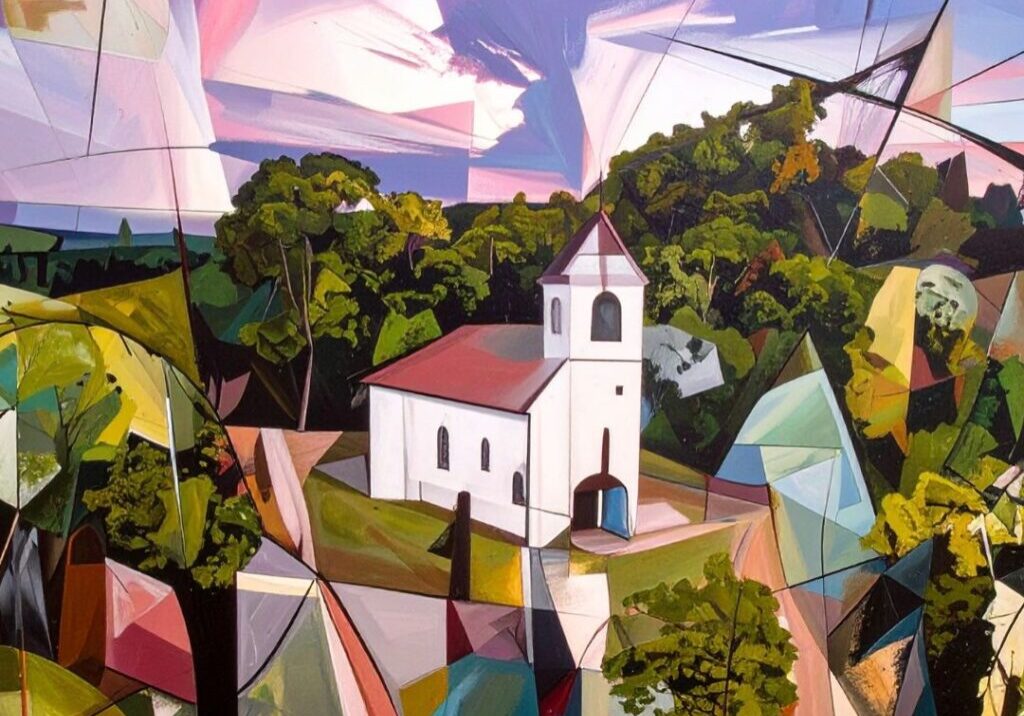Death Anxiety and the Cross
This week Christians around the world celebrate the suffering, death and resurrection of Jesus Christ. The death of Jesus was simply horrific, the worst of what humans can do to one another, retold as a story that we have ritualized, memorialized and reenacted. But what have we learned from it? Human violence has not only continued but it has become more sophisticated today with drone killing, atomic and biochemical warfare, gun violence and senseless murder. The last one hundred years have been so filled with violence and death that we are no longer affected by it, if it does not affect us personally.
It is worth paying attention to the final days of Jesus’ life as they are recounted in the Gospels. An innocent man betrayed, humiliated, illicitly charged with political subversion and then tossed into the hand of an angry mob who demanded his death in exchange for the release of a criminal. Yet, he was “led as a lamb to the slaughter,” accepting his fate of death without resistance. What kind of person willingly accepts death at a young age, unless one is driven by a belief or commitment that is stronger than death? From the beginning of his life, there was something different about Jesus. Raised in a Jewish household and faithful to the Jewish rituals and feasts, Jesus experienced the God of Abraham and Moses at the heart of his own life. The Spirit of the Lord was upon him in such a way that he had a felt experience of God within him. He was a simple man, and likely uneducated, and he worked as a carpenter until he felt impelled to speak out on behalf of the reign of God—as if something new broke through within him—what Larry Hurtado and others have called, a mutation of consciousness. The power of God ignited in him, and from this power a new type of person, a Godly-person, emerged.
Jesus changed the human boundaries, showing himself to be human and Godly at the same time. The power of Abraham’s God was now expressed in a human person. This “incarnation” was so contrary to common sense, it destabilized reified categories. Deliberately showing up as a human with God-consciousness, Jesus revealed the arbitrariness and constructed nature of what others considered to be the norm. His life and ministry disrupted established values. This deeply felt presence of God within him pushed Jesus beyond the norm. He became a disrupter, a trickster, one who deceived others by not delivering their expectations. “Isn’t this the carpenter’s son?” they asked. Jesus showed that Godly life is about overcoming all obstacles and dualisms that stand in the way of new and deeper personhood toward unity and community. Brandon Ambrosino’s brilliant dissertation on Camp ethics portrays Jesus as one who “doodled,” randomly changing boundaries and disrupting expectations. Jesus “doodled God,” Ambrosino states, in such a way that power structures of domination, threatened existence and exclusion were not resisted but were dismissed with a laugh, a doodle, a spontaneous dare or an outrageous act of healing or forgiving that completely disarmed (and enraged) his opponents. Jesus was uncontrollable because he was entirely free. There was a power at work in him, not a power of domination but a power of love, forgiveness and compassion, a sheer desire to lift up the fallen, help the wounded and heal the sick. Jesus was about the human person and the inclusion of all persons in community. He shifted the focus of God from above to within and showed that God is always the more of anything that exists. He lived from what Beatrice Bruteau called, “spondic energy,” the spontaneous energy of love that propels one into creative relationships.
Jesus’ death was already inscribed on the day he was born, in the same way that our death is already a given, from the moment we open our eyes in the universe. We live in a sense to die because death is the final form of our personality, the footprint we leave on the cosmos for all eternity. Death is not the end but the first full act of personhood. How we live into that first full act of personhood is the journey of life itself. The smaller we live, the more selfish we are, the less we contribute to eternal cosmic creativity of life. This is our final judgment.
Jesus acted as one who was lawless, subversive, yet one who was entirely without a separate ego; his radical freedom was the radicality of love, compassion, forgiveness, mercy, healing and hope. To act in subversive love is to know that death is part of life. Jesus began his ministry unafraid to die because the power of God was so strong in him that life itself could not be extinguished. Radical love requires one to live in the ultimate victory of life, which is God.
While Jesus learned to pray in the Temple, listening to the prophets and reciting the psalms, I wonder how much of his personal religious imagination was learned from nature. “See how the lilies of the field grow,” he said. “They do not labor or spin. Yet I tell you that not even Solomon in all his splendor was dressed like one of these” (Mt 6:25) Nature lives in the radicality of love by simply being itself. Trees and flowers, fish and fowl, and all living creatures of the earth, exist in their unique creatureliness. “A tree does nothing more than be a tree, and in being a tree, it gives glory to God,” Thomas Merton wrote. Nature does not suffer from death anxiety or fear death, as humans do; rather all of nature yields to death in the flow of life. Life pushes through the charred remains of dead trees and violent explosions, through volcanic ash and earthquakes; life finds a way to miraculously sprout up again, emerging triumphantly somehow and somewhere in new life. The last word of life is Life itself—and this is God.
The willful violence of nature begins with human evolution and the rise of self-reflective consciousness. We humans not only know but we know that we know. And what we know is that we will die. One of the earliest signs of human complex brains is found in the prehistoric cave art in Lascaux France portraying, among other things, symbols of death. Death is woven into the story of Adam and Eve in the book of Genesis. Death anxiety is a psychological condition that has plagued humans through the centuries.
Today the modern world has fallen into a new death anxiety in light of nuclear warfare and mass extinction, that is, the threat of existential annihilation, that one’s life may be annihilated in an instant of time. The thought of being personally erased in the universe by death has driven the modern person to do everything in one’s power to preserve a cosmic footprint, from heroic deeds of kindness to mass accumulation of wealth to building monuments, endowing college buildings, or volunteering in a soup kitchen. We want to be remembered for something, however small or great. For some, even criminal behavior may be a better remembrance than not being remembered at all. Both good and evil can leave an indelible mark on history.
Actually, I wonder if death anxiety does not stand behind the construction of the doctrine of original sin, the theory of satisfaction, and the belief that Jesus saves us from sin and death. For there is a logical gap between the New Testament and the later formulation of Christian doctrine. Paul Tillich pointed out that the eleventh-century doctrine of Saint Anselm, known as the theory of satisfaction, captured our attention because it appeases the burden of guilt, the experience of moral failure, and the impossibility of making up for what we have done due to the universal condition of sin. Christ restored the order of justice subverted by sin. Other theories of atonement, including penal substitution, have also been proposed over the centuries to appease the burden of guilt in a misshapen humanity who fears final judgement and eternal punishment.
The doctrine of atonement and the subsequent penal substitution theories are rather late developments in Christianity. In other words, they are not immediately associated with Jesus of Nazareth. In the first few centuries of the Church, emphasis was on Resurrection and new life in God, rather than on satisfaction due to sin. In fact, atonement theory and trinitarian theology emerged as co-relative doctrines after Augustine. As God shifted from the living power of life, consciously alive in Jesus, to an inward, essential, immutable and perfect being, so too original sin, formulated by Augustine, began to shape a fallen humanity. Divine omnipotence and human depravity become co-relative. Christianity was constructed on death anxiety and the existential threat of nothingness in such a way that we never got to drink from the wellspring of resurrected life, the spontaneous, generative life in the Spirit that is creatively new, hopeful and future-oriented.
Jesus did not die for you and me; Jesus died into the wholeness of love. “It is finished,” he said. Love is complete when we have done all that we can to actualize love in the persons we are. Jesus died a gruesome death because he believed that God would not be extinguished by the terror of human power. And he was right. Death is not our enemy; the distortion of power is our enemy, a power arising from a level of thought locked into our own selfish fears. In some ways, the intellectual life has disconnected us from the whole of life. We pride ourselves on the power of the ideas; we think we can save ourselves but we have lost how to be ourselves.
Jesus is a tremendous model on how to be a human person, open to and in relationship with the power of life itself, the power of God. To be human is to embrace death all along the way of this journey into the wholeness of life, into the fullness of God-consciousness. It is so unfortunate that we have made Jesus a medium of God and not the actuality of God’s presence and aliveness. Jesus is not the instrument of God’s love; Jesus is God alive and loving in the flesh. We simply cannot get our heads around the fact that God is the name of Life itself, not a Being but the dynamism of Being alive, relational, active, oriented toward more life. To pray to God does not simply call for an act of worship; rather to pray is to be conscious of God’s aliveness within us and around us. Worship calls for a new aliveness in celebration and community, anticipating a new future together and celebrating this new life emerging in our midst.
Easter celebration should not be constrained by formulaic prayers or long-winded liturgies; it should be an all-out celebration of life, not just a small fire to light a tall candle, but an all-out fireworks display, a shouting out that life cannot be extinguished by death, a commitment to all that we have and all that we are to the fullness of life; that we who believe that God is active and alive in the human person, in all trees, plants, small animals, living creatures of the earth, alive in the stars and sun and moon, that if we know ourselves filled with this God of life, that we will throw ourselves into the paths of life blocked by injustice, war, recklessness, carelessness, greed, poverty; that we will be disrupters, doodlers, spontaneous creators, because we are filled with the Spirit of new life. Death has no power over us; death has been conquered by death. Jesus is raised to new life in God. No matter what happens, we will not die. Death anxiety or the threat of personal annihilation belie the Christian commitment. It is time for Christians to wake up and shake off the shackles of original sin and atonement theories. They have not only depressed the spirit of creativity and new life, they have thwarted the real meaning of Christian commitment—to doodle, disrupt and awaken the imagination because new life is on the horizon, and someone is bound to grab it. Jesus did not die for you and me. Jesus died out of love, and it is time for us to do the same.
 View print-friendly version
View print-friendly version
36 Comments
Related Posts

Mission for an Evolutionary Christianity
We are living through tumultuous times. Political polarization intensifies, violence against vulnerable populations escalates, and the foundational principles of human dignity face erosion. For many, the cognitive dissonance between professed…


wow. this is brilliant 👏
Thanks, Ilia. A wonderful Easter message!!
You are amazing!!!! Thank you so much for these powerful thoughts – disruptive technology – breaking the shackles – may we all follow the voice of the Shepherd and not allow ourselves to be constrained by constructs given to us by this world. We are in the Kingdom of God now – Jesus please show us how to act as if and know this is true.
I am broken hearted about the people of Gaza and the violence, the starvation.
I will be pondering on the “mutation of consciousness”, and on celebrating Resurrection and New Life, rather than Atonement, from now on.
The Jesus movement came to set us free from lower order ways of being and doing, toward God-identity in a higher order, and from religious form and institutional pomp, to TRANS-form — spiritual consciousness in him. Such is a standalone reality that differentiates itself from all religious and institutional form. The early church had it, began with the basics, then got derailed. Has never been the same since, save for a grain of salt here, and a ray of light there. Puts christogenesis on a s-l-o-w track, with time running out on the earth-unsustainability-nuclear-annihilation clock. Look what it did to Teilhard, sent into 3 exiles, the last to an early death Easter Sunday 69 l-o-n-g years ago today. Can’t have a ‘Church Triumphant’ without a ‘Church Militant’ in the best sense, which the Word calls “workmen, soldiers, and athletes.” No place for the lukewarm or faint- hearted. Special forces are needed, ordinary foot soldiers haven’t gotten it done.
Amen Joe! We are out of time!
A beautiful and powerful Easter message, thank you!
That Easter occurs in Spring is no mistake. For eons the miracle of Earth’s renewal was a reminder of the greatness of God. By whatever name, God was renewing the Earth so that all creation might rejoice and replenish. The People and Nature would exist in an entangled web of relationships held most Sacred by an Easter practice lived within every facet of their existence.
In Indigenous cultures still practicing their Indigenous beliefs this is still the way. Children are taught the Incarnational way of living from cradle to grave.
However, for those of Christian faith, there is this wrestling over being born with original sin or not. Jesus, the man, dying for our sins-or not. If we are made in the image and likeness of God then how can we be born with sin? How can a baby be born with sin? Is being born into a world filled with Christ a sin? I don’t believe so. I believe sin was another concept developed by humans, a personal decision made public after review, for acceptance of penance, indulgences, and all that came after.
Jesus dying on the cross was who he was. Fully aware of his part as the “Strange Attractor” ( Ilia Delio – Quantum Mechanics) here to complete his part in the complicated initiation of “The Way”. He was a rebel, someone who
“stirred he pot” and upset the status quo.
But it wasn’t to establish Christianity. It was to establish The Way. The guide for how to respond to those who had come and destroyed. How to respond with love.
I look around at Easter and weep.
Yes. All I can say to this is Yes and Yes again.
This is the language I have been looking for.
Thank you.
It is Easter Sunday morning.The sun is shining there is snow on the mountains spring is bursting out with blossoms, primulas,bluebells,hyacinths,and in my lane daffodils are dancing in the breeze rejoicing that Christ Is Risen. I am not a Roman Catholic but I shall go to Mass to celebrate with other believers and I hope to find Life and Love bursting forth.
Awesome reflection! Thank you, Ilia!